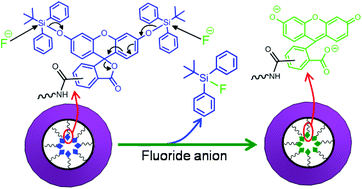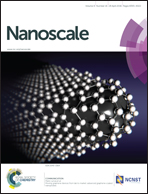Fluoride-induced modulation of ionic transport in asymmetric nanopores functionalized with “caged” fluorescein moieties
Abstract
We demonstrate experimentally and theoretically a nanofluidic fluoride sensing device based on a single conical pore functionalized with “caged” fluorescein moieties. The nanopore functionalization is based on an amine-terminated fluorescein whose phenolic hydroxyl groups are protected with tert-butyldiphenylsilyl (TBDPS) moieties. The protected fluorescein (Fcn-TBDPS–NH2) molecules are then immobilized on the nanopore surface via carbodiimide coupling chemistry. Exposure to fluoride ions removes the uncharged TBDPS moieties due to the fluoride-promoted cleavage of the silicon–oxygen bond, leading to the generation of negatively charged groups on the fluorescein moieties immobilized onto the pore surface. The asymmetrical distribution of these groups along the conical nanopore leads to the electrical rectification observed in the current–voltage (I–V) curve. On the contrary, other halides and anions are not able to induce any significant ionic rectification in the asymmetric pore. In each case, the success of the chemical functionalization and deprotection reactions is monitored through the changes observed in the I–V curves before and after the specified reaction step. The theoretical results based on the Nernst–Planck and Poisson equations further demonstrate the validity of an experimental approach to fluoride-induced modulation of nanopore current rectification behaviour.


 Please wait while we load your content...
Please wait while we load your content...